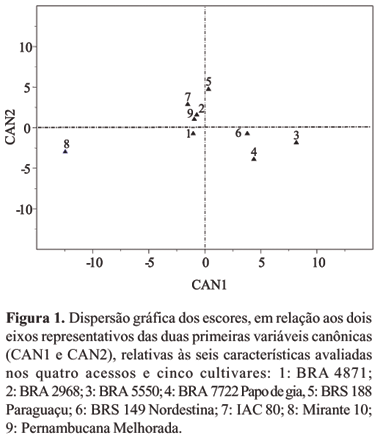This work aimed to evaluate genetic divergence among castor bean (Ricinus communis L.) cultivars, in order to enable the choice of parents which make the formation of segregating populations possible. Accesses BRA 4871, BRA 2968, BRA 5550 and BRA 7722 Papo-de-gia, and cultivars BRS 188 Paraguaçu, BRS 149 Nordestina, IAC-80, Mirante-10 and Pernambucana Melhorada were evaluated. Characteristics analyzed were: days to flowering, number of racemes per plant, length of pistillate region of main raceme, plant height, potential yield, and seed oil content. The genetic divergence among accesses and cultivars was studied by multivariate analysis techniques, with canonical variables and cluster analysis, making use of mean euclidean distance. Two groups were formed: group I, formed by eight genotypes; and group II, formed by one genotype, cultivar Mirante-10. In spite of being the more divergent, cultivar Mirante-10 should not be recommended for hybridization due to its low medium performance. The other cultivars also presented restrictions, as they were quite similar. The variables that more contributed to the genetic divergence were: days to flowering, length of pistillate region of main raceme, plant height, and seed oil content.
Ricinus communis; genetic variation; cluster; multivariate analysis

 Genetic divergence on castor bean accesses and cultivars through multivariate analysis
Genetic divergence on castor bean accesses and cultivars through multivariate analysis



